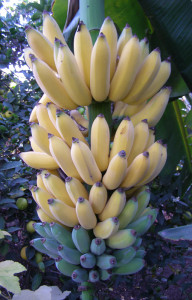- We missed the first UK fungus day yesterday.
- And the new world record pumpkin. Love that wide-angle lens, BTW.
- And a training course on plant genetic resources and genebank management.
- But not plant biodiversity to regenerate more productive pastures.
- Nor efforts to conserve navara red rice.
- Kudos to Ghana, the first country with a national yam strategy.
- And to Australia, for muddying the linguistic waters with something called a PlantBank.
- Local farmers supply the food for school meals in Africa.
- By far the strangest thing I’ve seen since a seed exploded a spliff some while ago.
Nibbles: Russian ‘rooms, CWFS, Small farmers and their systems, CABI pest maps, Aussie aid, Seed saving pod, Fiji video, CWR conference, Baobab & peanut festivals, Caribbean meets, Irish food security meet, Potty for pots, Salty microbes, Domesticated stomata, Bayer in Hyderabad
- Normal Russians hunt mushrooms.
- Committee on World Food Security meets. Not many people hurt.
- Normal Indian farmers go back to the future. So, in a different way, do Egyptian farmers. Rikin Gandhi probably knows all about it, and has made videos of it.
- I wonder if they’ve told the folks at the new, very agroecological Berkeley sustainable food institute. Though some would suggest they’re on a hiding to nothing there.
- You want past and future? Historical records used to predict spread of pests.
- When is development aid not development aid?
- Cherfas on Cavagnaro on seed saving. Trifecta.
- Cool ACIAR videos take me back to my stint in Fiji.
- International Conference on Utilization and Conservation of Crop Wild Relative (CWR) and Landrace (LR) Diversity for Crop Improvement. First order of business: think of a new name.
- Eden has a Baobab Festival. No word on the factsheet situation. But maybe you’d rather play it safe and try a peanut festival instead? OK, how about Coconuts of the Caribbean? No? Agrotourists of the Caribbean, then?
- Our Food. Our Future. Sustainability: The Bottom Line. Their presentations. Tell me if you find any agrobiodiversity in there. Well I dunno, maybe there will be some in the upcoming 2020 Policy Consultation on Building Resilience for Food and Nutrition Security, in 2014.
- Can you grow baobabs in a pot, I wonder? Or hydroponics for that matter.
- Salt-tolerant bacteria assist rooting in degraded soils. Easier than breeding, I guess.
- No consistent effect of domestication on stomata. Worth a try.
- Bayer goes to Hyderabad. To be near ICRISAT?
Local Samoan banana variety a hit in NZ
 My friend and former colleague Stephen Hazelman of the Secretariat of the Pacific Community (SPC) has been telling me about his new toy, a drier that an NGO in Samoa called Women in Business Development Inc. is using to process a local banana variety for export to New Zealand. You can see it on the left, thanks to Stephen. Drying overcomes the need for quarantine treatments in NZ. They harvest from certified organic farmers, ripen the fruits for 4-7 days, peel, soak in lime juice to stop blackening, then put in the drier for 15-20 hours, cool and pack in nice yellow 50g packages for export. They are also looking at teas, cinnamon, other fruits like pineapple and mangos, and also vegetables.
My friend and former colleague Stephen Hazelman of the Secretariat of the Pacific Community (SPC) has been telling me about his new toy, a drier that an NGO in Samoa called Women in Business Development Inc. is using to process a local banana variety for export to New Zealand. You can see it on the left, thanks to Stephen. Drying overcomes the need for quarantine treatments in NZ. They harvest from certified organic farmers, ripen the fruits for 4-7 days, peel, soak in lime juice to stop blackening, then put in the drier for 15-20 hours, cool and pack in nice yellow 50g packages for export. They are also looking at teas, cinnamon, other fruits like pineapple and mangos, and also vegetables.
 The variety involved is a small, sweet, high-altitude local type called Misi Luki. You can read all about its history and characteristics, and also see some pictures here. 1 It’s listed in ProMusa’s checklist of banana cultivars as an AAB type. If the banana were a neglected or underutilized species (NUS), Stephen could have reported on this under the “upgrading value chains” theme of the recent conference in Accra. But of course what works for weird and wonderful local landraces of the staples could also work for NUS. No news on whether Misi Luki is on any gourmet menus. But that’s another story…
The variety involved is a small, sweet, high-altitude local type called Misi Luki. You can read all about its history and characteristics, and also see some pictures here. 1 It’s listed in ProMusa’s checklist of banana cultivars as an AAB type. If the banana were a neglected or underutilized species (NUS), Stephen could have reported on this under the “upgrading value chains” theme of the recent conference in Accra. But of course what works for weird and wonderful local landraces of the staples could also work for NUS. No news on whether Misi Luki is on any gourmet menus. But that’s another story…
Nibbles: Hunger, Food surplus, Bananas not killing crocs, Overpopulation matters, NUS 2013, Berry go Round, Call for articles, Wild cabbage
- How to solve world hunger, eat a new report.
- Or send them the UK’s surplus oats and wheat.
- Our friend Anne Vezina lets the reptiles of the press have it right between the eyes: Crocs and banana plantations: What the media missed.
- And Erik Hammar is peeved about a New York Times op-ed pooh poohing the problem of overpopulation.
- Glad we’re not too late to point you to the write-up of the 1st day of the NUS 2013 conference. More to come?
- There’s a new Berry go Round botany blog carnival up, with nothing of agricultural interest. I guess we missed the call for content. Again.
- Farming Matters wants your articles on agricultural biodiversity.
- In a cabbage taste test, wild is best.
Brainfood: Adaptation priorities, Sorghum genomics, Rice seed storage, Barley DNA, Nutrition breeding, Variety adoption, Croatian wine, Chinese eggplants, Finger millet breeding, Fruit & veg
- Global Climate Change Adaptation Priorities for Biodiversity and Food Security. Changes in crop suitability + changes in suitability for restricted-range birds = 10 priority areas.
- Whole-genome sequencing reveals untapped genetic potential in Africa’s indigenous cereal crop sorghum. Two domestication events. At least.
- Association analysis of seed longevity in rice under conventional and high-temperature germination conditions. 10 markers on 5 chromosomes explain 10% of the variation in seed longevity. Fascinating, but one wonders if the game is worth the candle.
- Analysis of DNA polymorphism in ancient barley herbarium material: Validation of the KASP SNP genotyping platform. It’s a brave new world we live in.
- DNA evidence for multiple introductions of barley into Europe following dispersed domestications in Western Asia. European Neolithic barley falls into 3 distinct groups which originated in different places in the Near East and entered Europe via different routes at different times. And they didn’t even look at herbarium material.
- Plant breeding for nutrition-sensitive agriculture: an appraisal of developments in plant breeding. Pick your target, bring in complementary expertise, and don’t rely on the commercial sector.
- Impact of Improved Seeds on Small Farmers Productivity, Income and Livelihood in Umruwaba Locality of North Kordofan, Sudan. Dismal scientists tell farmers to adopt improved peanuts based on bunch of clever maths. What could possibly go wrong?
- Classification of Croatian wine varieties using multivariate analysis of data obtained by high resolution ICP-MS analysis. 75 of them!
- Analysis of genetic diversity and structure of eggplant populations (Solanum melongena L.) in China using simple sequence repeat markers. 92 accessions, 7 geographic ares, 4 clades. As ever, “(t)he results will be useful for eggplant germplasm management and will lead to more efficient use of germplasm in eggplant breeding.” Riiiiiight.
- Heritability, variance components and genetic advance of some yield and yield related traits in Ethiopian collections of finger millet (Eleusine coracana (L.) Gaertn.) genotypes. Some simple selection could improve yields.
- Feasibility of Using a Community-Supported Agriculture Program to Improve Fruit and Vegetable Inventories and Consumption in an Underresourced Urban Community. In smallish randomized controlled trial, 5 educational sessions and a box of fresh produce for 16 weeks results in more diverse foods in the house, and maybe even more fruit and veg consumption, compared to households which got nothing. Which is good, but the comparison doesn’t seem fair, somehow.